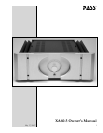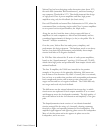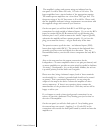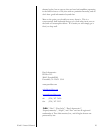
8
XA60.5 Owner’s Manual
XLR. If you re-install the jumper incorrectly or leave it lying about,
the amplifier will not work properly, and you will be able to tell.
Choose either XLR or RCA inputs. If you run both at once from
different components, the sound is not likely to be optimal, but it
shouldn’t cause damage anywhere.
Now that the source component is connected, turn the volume all
the way down. Plug the power cord back into the wall, and turn on
the rear power switch.
Push the front panel button to activate the amplifier. The lights will
come on.
You are ready to play music
With any luck, you can now enter that blissful state, and we won’t
expect you back for a while.
It’s always possible that something may go wrong. If so, don’t get
excited. We know It’s really aggravating when a product doesn’t
work, but it will get fixed, and often it’s something really simple.
We go to a lot of trouble to make products reliable, and the failure
rate of our amplifiers is very low. This is small comfort to the few,
but take it easy and give us a call if you have problems.
People are interested in how long it takes for these amplifiers to
break in. Depending on the resolution of the rest of your audio
chain, you may or may not notice any break in of the amplifier
beyond the first few hours of operation. You will very likely notice
the difference in sonic character between cold and normal operating
temperature over the first hour, so we recommend letting these
amplifiers warm up before any serious listening.
This generation of amplifiers warms up faster and is more bias-stable
during warm up than previous versions, but we still recommend an
hour for critical listening. At the factory we adjust the bias and offset
values initially and then after warm-up and then again after 48 hours,
If necessary. The “sweet spot” is a sink temperature between 50 and
55 degrees C., but this is not critical, and will vary with your room
temperature. You should be able to put your hands on the heat sinks
without undue discomfort for 5 seconds or so.
The amplifier has a thermal cutout that will disconnect AC power if
the temperature exceeds 75 degrees Centigrade. This thermal cutout















